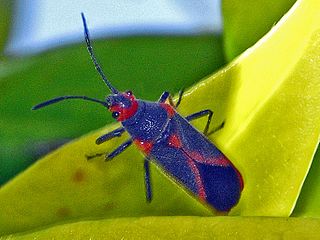
Pentatomidae is a family of insects belonging to the order Hemiptera, generally called shield bugs or stink bugs. Pentatomidae is the largest family in the superfamily Pentatomoidea, and contains around 900 genera and over 4700 species. As hemipterans, the pentatomids have piercing sucking mouthparts, and most are phytophagous, including several species which are severe pests on agricultural crops. However, some species, particularly in the subfamily Asopinae, are predatory and may be considered beneficial.

Pentatominae is a subfamily of Pentatomidae, a family of shield bugs. This subfamily is the largest one within the Pentatomidae, having 4937 species classified in 938 genera. Species in this subfamily are phytophages and several of them are considered agricultural pests. Some invasive pentatomines such as Halyomorpha halys and Bagrada hilaris have been considered household pests. Higher systematics of the group have been revised by Rider et al.

Alydidae, commonly known as broad-headed bugs, is a family of true bugs very similar to the closely related Coreidae. There are at least 60 genera and 300 species altogether. Distributed in the temperate and warmer regions of the Earth, most are tropical and subtropical animals; for example Europe has a mere 10 species, and only 2 of these occur outside the Mediterranean region.

The Harpactorinae are a large subfamily of the Reduviidae. About 300 genera and 2,000 species worldwide have been described. Some of the species of the genera Zelus, Pselliopus, Sinea, and Apiomerus are of interest as biological pest control agents.

Sphedanolestes is a large genus of assassin bugs in the family (Reduviidae), subfamily Harpactorinae. There are more than 190 described species, which are found in southern Europe, Africa and Asia.
Antestia is a genus of African and Asian bugs in the subfamily Pentatominae, erected by Carl Stål, 1865.

Scutellerinae is a subfamily of shield-backed bugs erected by Leach in 1815.

Edessa is a large New World genus of stink bugs in the family Pentatomidae, containing over 250 described species. Several other genera used to be included until recently, such as Pygoda, Ascra, Paraedessa, Doesburgedessa and others.

Pentatomini is a tribe of shield bugs in the subfamily of Pentatominae.

Lygaeinae is a subfamily of ground bugs in the insect family Lygaeidae.

Halyomorpha is a genus of shield bugs in the subfamily Pentatominae and tribe Cappaeini, erected by G. Mayr. This genus probably has an Asian centre of origin, but Halyomorpha halys, the brown marmorated stink bug, is an invasive species with a world-wide distribution.

Drymini is a tribe of dirt-colored seed bugs in the family Rhyparochromidae. There are more than 300 described species in Drymini.

Podopinae, known as turtle bugs, are a subfamily of the insect family Pentatomidae. The type genus is Podops.

Carpocorini is a tribe of stink bugs in the family Pentatomidae. There are more than 100 genera in Carpocorini.

Geocoridae is a family of big-eyed bugs in the order Hemiptera. There are more than 290 described species in Geocoridae.

The Micrelytrinae are a subfamily of true bugs in the family Alydidae, based on the type genus Micrelytra Laporte, 1833. Genera are recorded from the Americas, Europe and Asia.

The Phyllocephalinae are a subfamily of shield bugs erected by Amyot and Serville in 1843.















